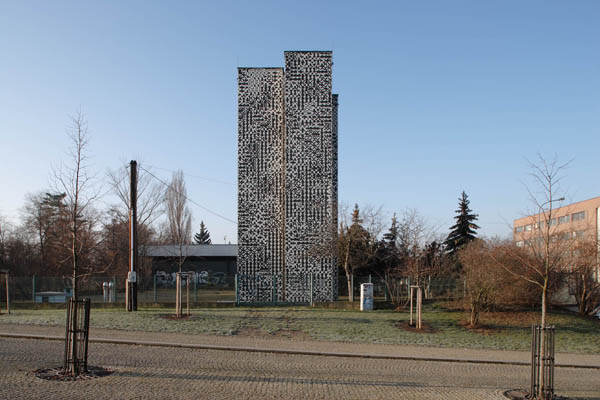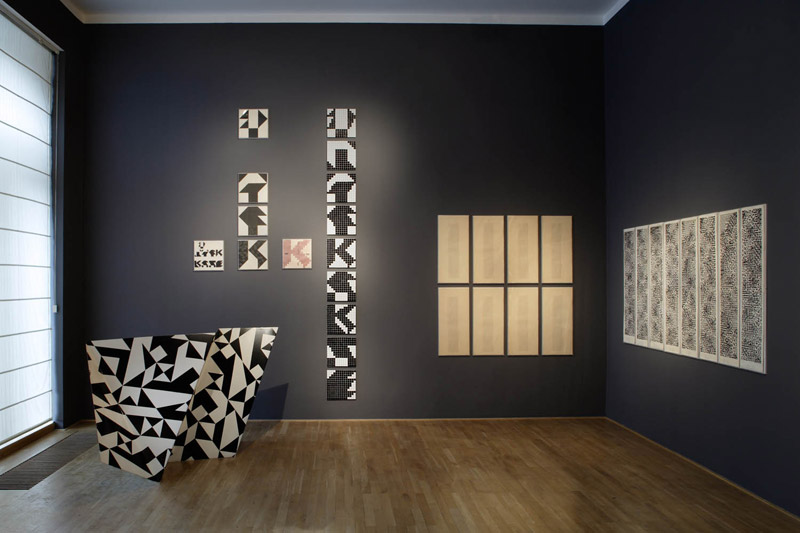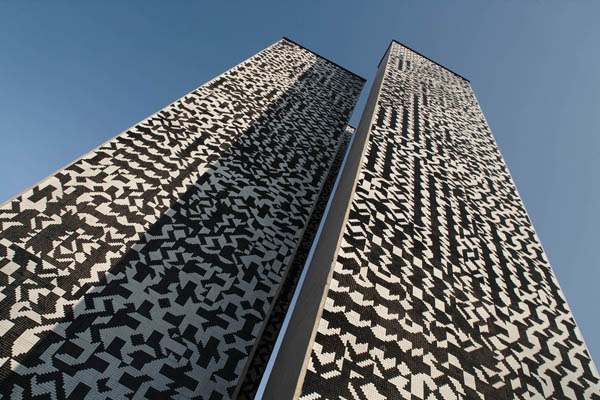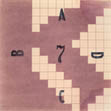texts about zs
Possibilities of integration
"JH: And to conclude from another end: are your Structures just designs for implementation in architecture, or are they also independent works of art in their own right? ZS: My Structures are independent works of art that can be integrated into architecture." (Footnote 1)
Out of Sýkora´s whole body of work, it is his Structure artwork that is the most suitable for integration with architecture (footnote 2). Their emblematically modern expression, unlike almost anything else found in Czech art up to that point, their regular design mirroring the technology of tiled cladding, and not least of all the utilisation of a computer in their creation, predestined the for this purpose.
This was further aided by a time that favoured the integration of fine art and architecture. Not only were the Sixties a period of the adoption of new building methods and technologies, but the general transitional liberalisation allowed Western ideas to be absorbed more freely, to be discussed and in some cases even expand on the ideas of avant-garde architecture (footnote 3). The utopian ideals of the period of liberalisation were further fuelled by a belief in a better organisation of society and especially an optimistic attitude towards civilization and technology (footnote 4).
Taking that into consideration, it is not surprising that Sýkora´s Structures gradually found use in architecture. However, in practice, the promotion of such radical new ideas is not easy under any circumstances, even in an environment with a sophisticated culture and society. For an example of this, we need only to look at the recently concluded debate regarding the new National Library building. Paradoxically, back then in Czechoslovakia, these progressive ideas were first adopted and voluntarily accepted by an organisation which, due to its name, we would today hardly expect – the Military Construction Project Institute, although this was one of the largest construction project management organisations at the time. In the Sixties, Sýkora´s collaboration with the architect at the institute, Mr Kales, yielded his only two completed commissions in the capital (footnote 5): the tile wall in the covered passageway nest to what used to be the Polish Information Centre on Jindřišská Street (completed 1968), which the artist says served as a trial run (footnote 6) for the second project, the mosaic facing of the four Letná Tunnel ventilation shafts (completed 1969). From this last work up until 1993 we can find Sýkora´s works realised in just two cities – Litvínov in northern Bohemia and Gorinchem in the Netherlands.
In an interview with Vladimír Burda, Sýkora mentioned that architect Kales suggested collaborating after having seen his work at exhibitions (footnote 7). Understandably, it was not easy to break through with such a thoroughly contemporary creative concept, which for a long time remained unacceptable for many in Czech artistic circles. In another interview, Zdeněk Sýkora recalls that in the end it all came to pass thanks to a few enlightened minds on the Arts Committee (footnote 8).
In 1970, with Jindřich Chalupecký´s assistance, Zdeněk Sýkora managed to put on a retrospective exhibition at the Václav Špála Gallery. Soon after, the new regime attempted to “normalize” him, a fate that befell all citizens of Czechoslovakia who either did not want to or missed their opportunity to emigrate. Sýkora was advised to voluntarily resign from his post at the Faculty of Education, which he refused. Surprisingly, nothing happened, although his deserved academic advancement was halted until his retirement.
While at home his fortune waned and his Letná mosaic seemed to be the gravestone of his artistic career, interest in his work among foreign galleries and theoreticians grew. In 1968 he exhibited at Documenta in Kassel; in the same year he was completing work on his mosaic in Letná, he participated in the 1st Biennale of Constructivist Art in Nuremberg and, for the second time, Zagreb´s New Tendencies – this time in person. In the late Sixties and early Seventies, his paintings and sculptures found their way into prestigious European and American galleries, museums and private collections.

Thanks to these successes, in the early Seventies he received regular invitations to participate in various events. He had to turn most of them down. In 1974 he participated “long distance” in a symposium in the Dutch city of Gorinchem. Its theme was art in public spaces. A pavement mosaic was constructed in accordance with his plans, on the corner of the city´s Gasthuistraat and Hasrstraat streets. Other participants included some highly regarded names in the circle of “New Tendencies”: Getulio Alviani, Marinus Boezem, Ad Dekkers, Kees Franse, Ewerdt Hilgemann, Ad de Keijzer, Kenneth Martin, Christian Megert, François Morellet, Lev Nusberg, Panamarenko, Uli Pohl, Karl Prantl, Herman de Vries and Ryszard Winiarski. At the time, though, none of them could boast of such large-scale projects at such a frequented place. Very few could understand why an artist who is permitted such an official expression of his personal avant-garde vision was unable to personally participate in the opening of the symposium and instead had to mail his plans.
In 1970, together with Jaroslav Blažek, he wrote a sizable article about his work entitled Computer-aided Multi-element Geometrical Abstract Paintings for the international magazine Leonardo, published by Frank Malina. The article outlines the creation of Structures and the illustrations included photographs of the completed wall in Jindřišská Street and a model of Letná´s ventilation shafts...

1 Hlaváček, Josef: Otázky pro Zdeňka Sýkoru (Questions for Zdeněk Sýkora), Výtvarné umění (Fine Art), 1968, No. 3, pp. 110-117.
2 Zdeněk Sýkora perceives the functional connection of artistic expression with architecture as a confirmation of its contemporariness: „I consider the ability of painterly or sculptural expression to become integrated into architecture to be proof of the topicality of this expression. It always feels good when the work created in a closed-off studio begins to function in everyday social intercourse. The installation of my mosaic on the Letná Tunnel ventilation shafts and the ceramic Structure on Jindřišská Street in Prague perform this function.“ See footnote 2. Here it is relevant to note Petr Wittlich´s article from 1970, the title of which we borrowed for the heading of this chapter. In it he examines several historical aspects and contemporary questions on the synthesis of art and architecture. Wittlich, Petr: Možnosti integrace (Possibilities of integration), Výtvarné umění (Fine Art), 1970, Vol XX, No. 6, pp. 254-267.
3 See Hájková, Ludmila – Švácha, Rostislav: Kde budeme žít zítra (Where W Will Live Tomorrow), in Havránek, Vít (ed.): Akce, slovo, pohyb, prostor. Experimenty v umění 60. let (Action, word, movement, space: Experimental art of the Sixties), City Gallery Prague, PRague 1999, p. 114.
4 From the fine art field, let´s recall the texts of Jiří Padrta, especially the Konstruktivní tendence (Constructivist Tendencies) mission statement (1966) or text in the Nová citlivost (New Sensitivity) exhibition catalogue (1968). That catalogue also contained a questionnaire concerned with the relationship between the participating artists and current civilization. At the time, Sýkora´s answer to this question was: „it is impossible to avoid civilization; civilization has a single direction: towards greater civilization. It should not be considered a separate phenomenon from art, as art has become a part of it and moves with it, or against it.“
5 While there are two completed commissions in Prague, we now know of three other projects that were being considered but were called off for various reasons.
6 „… in practice we had already verified a suitable system of facing for the Letná Tunnel ventilation shafts, for which I had designed a far more monumental glass mosaic.“ See footnote 1.
7 Burda, Vladimír: Pražský podchod (A Pedestrian Underpass in Prague), see footnote 1.
8 „In the late Sixties, the architect Josef Kales approached me and asked if I wouldn´t like to apply my idea of Structures in architecture. When we first went to the arts commission, we bombed. As it was the Sixties, though, there were still a few intelligent people sitting there – so in the end the ceramic tiles on Jindřišská Street were approved. I tried the same thing the second time for the Letná Tunnel ventilation shafts. Both projects were crateda with the aid of a computer. Jaroslav Blažek translated my idea into the computer´s language.“ Hůla, Jiří: Zdeněk Sýkora´s œuvre at the Municipal Library, Denní telegraf, Vol. 4, 8 June 1995, No. 133, p. 10.


